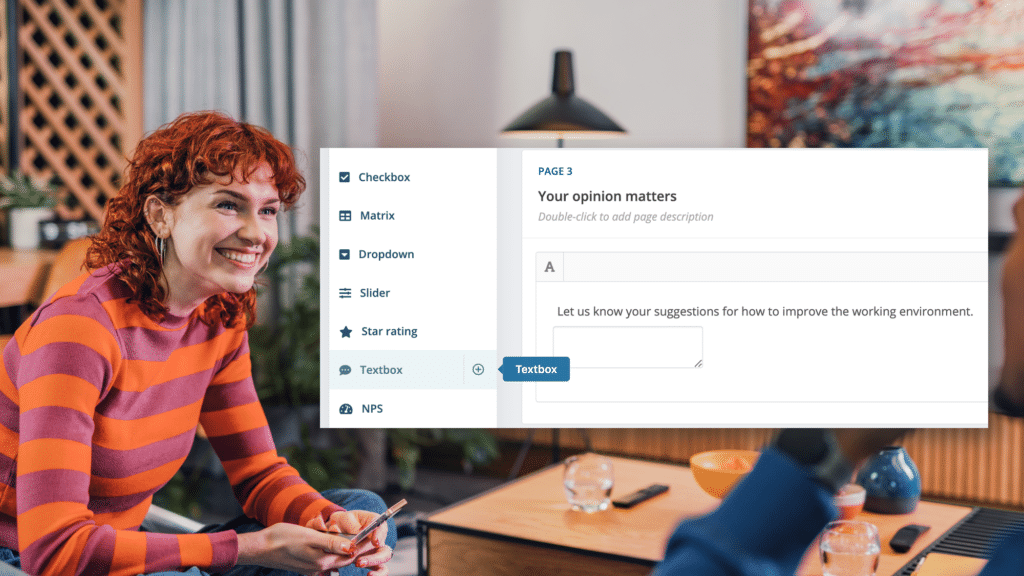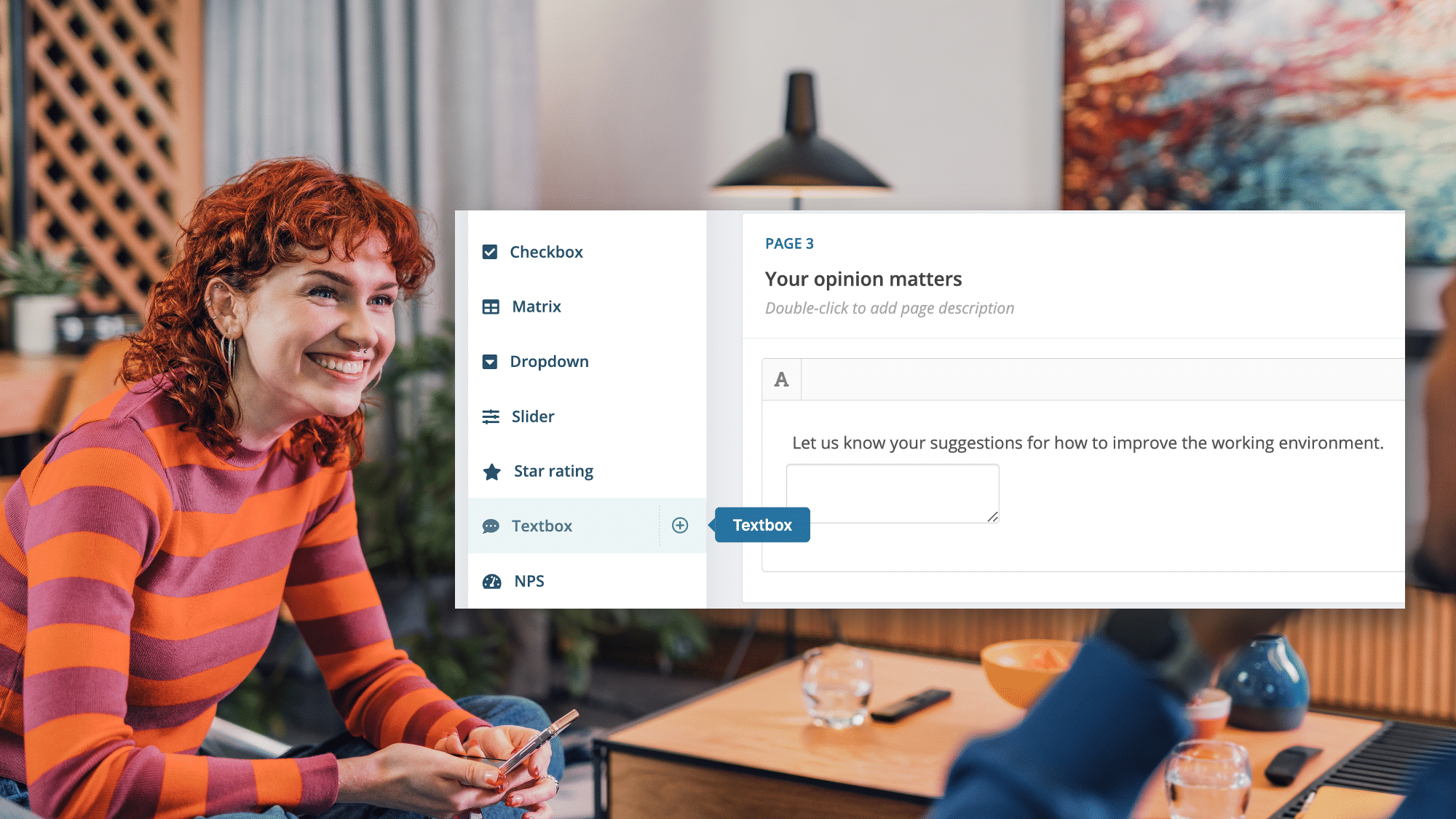Table of Contents
A survey expert’s guide to open ended questions

There are many factors to consider when collecting feedback to ensure that you gather the desired information. The way you phrase a question can have a significant impact on the quality of answers and data. You can call it fascinating or simply brain-racking. In the end, you can divide survey questions into two categories: closed-ended questions (for quantitative data) or open-ended questions (for unstructured, more qualitative data).
A closed-ended question refers to any question for which a researcher provides research participants with options from which to choose a response.
Examples of closed-ended questions:
- Were you satisfied with the service? Yes / No
- On a scale from 1-10, how satisfied were you with the service?
On the other hand, an open-ended question is a question that cannot be answered with a “yes” or “no” response, or with selecting a predefined category.
Examples of an open-ended question:
- What were you most satisfied with?
When to use closed-ended questions
As you might have noticed, most surveys are based on closed-ended questions, comprised of nominal, ordinal, or interval scales . Closed-ended questions are mostly easy for survey participants to answer, but obtain a limited set of data, which simplifies survey administration. Because closed-ended questions are easy to answer, they might be the preferred approach for some study designs, depending on the purpose of the survey. Furthermore, the responses can be easily coded and analysed.
Closed-ended questions are great for gathering insights, comparing results and measuring effects, but they have limitations. They don’t encourage personal reflection or explanations, leaving the “why” and deeper thoughts behind answers unexplored. Luckily, open-ended questions can unlock these insights and provide valuable context. By using open-ended questions, you can discover rich, unanticipated perspectives from respondents.
Qualitative research is now more accessible and less resource-intensive thanks to advances in technology. You can enhance your quantitative results by including qualitative questions that allow for greater depth and richness in responses. Take advantage of this by incorporating open-ended questions in your survey to unlock new insights and perspectives.
Overwhelmed by too many open text answers? You’ve got to try Text Analysis!
When to use open ended questions — and why
Asking open-ended questions in a survey can be a powerful tool for gaining deep insights into the thoughts, feelings, and experiences of your respondents. Open-ended questions allow people to share their ideas and perspectives in their own words, giving you a wealth of information that can help you make informed decisions. For example, when exploring customer experience in telecommunications, you might ask, “Can you describe a recent interaction you had with our customer service, and how it could have been improved?” This type of question allows customers to provide detailed feedback about their experiences, helping you identify specific areas for enhancement.
Use open-ended questions when you want to dive deeper into a topic or when you’re looking for new ideas and fresh perspectives. By asking open-ended questions, you’re inviting your respondents to share their unique experiences and insights, which helps improve customer engagement, and that’s where the magic happens.
Here are the four key benefits of collecting open-text answers:
Discover ‘unknown unknowns’
Open-text answers allow you to eliminate guess work, giving you valuable insights into exactly what your customers and employees need to remain loyal to your business.
Qualitative data meets quantitative
Take your data beyond quantitative metrics like (e)NPS and CSAT. Providing subjective opinions, ideas, feelings and emotions, open-text responses are essential for putting customer and employee numerical data and behaviour patterns into context.
Immediately close the feedback loop
When you know precisely what your customers and employees want — or what they don’t — you can take quick and targeted action.
Invest time and resources in the right place
Text Analysis enables you to provide your leadership teams with comprehensive, aggregated insights that will help to inform strategic planning and decision making.
New to Text Analysis? Download our quick start guide.
How to use open-ended questions in your surveys
Examples of open-ended questions for qualitative research can come in many forms: as a stand-alone question, as a follow-up to a closed-ended question, as comment sections, and many more. Let’s have a look at a couple of these and in which scenarios they can be valuable. Customer survey software can be particularly useful in designing these types of questions effectively. Additionally, when you create customer surveys, including open-ended questions can help gather deeper insights into your customers’ thoughts and preferences.
1. To complement closed-ended questions
a) At the end of a group of closed-ended questions or a grid:
Open-ended questions are an invaluable tool for gaining a comprehensive understanding. Not only do they provide additional information, but they also reveal hidden insights that may have gone unnoticed. When combined with closed-ended questions, open-ended questions help minimize the risk of bias resulting from misinterpretation. Moreover, if a question is unclear, respondents are more likely to provide feedback in the comment box. By embracing the power of open-ended questions, you can gain a fuller understanding of the big picture.
b) As an additional text field to add clarity or premise
To engage your survey respondents and gain valuable insights, consider including optional comment boxes or additional text fields. These features provide an opportunity for respondents to elaborate on sub-questions, such as those found in multiple-choice questions. However, be mindful of not overburdening your respondents and keeping the survey response time reasonable. By allowing respondents to expand on their closed-ended answers, you increase the likelihood of gaining additional insights and verifying other responses. With this approach, you can optimize your surveys for maximum engagement and data collection.
2. Free-standing open questions
Open-ended questions are a powerful tool for collecting valuable insights from survey respondents. By asking them ahead of closed-ended questions or as standalone queries, you encourage brainstorming and spontaneous responses free from prior influences. This approach is particularly useful for addressing complex issues and evaluating surveys.
To ensure the success of your surveys and avoid mistakes, it’s important to exercise caution. Before launching a series of surveys with a similar design, take the time to evaluate your questionnaire. Are there any areas that require more in-depth details or clarification? Incorporating open-ended questions can help identify such areas and prevent future errors, leading to more successful survey outcomes.
How to get the most out of open-ended questions with Text Analysis
What is Text Analysis?
Text Analysis is a powerful technology that leverages machine learning to extract insights from large amounts of text data. Rather than having to manually analyse this data, Text Analysis uses natural language processing to categorize responses and identify patterns in an unbiased and scalable way.
By automating this process, Text Analysis gives you a clear picture of what your customers and employees are experiencing in their own words, and helps you understand the “why” behind numerical feedback data. With Text Analysis, you can unlock the full value of open-ended questions and gain deep insights that inform your decision-making.
The good news is that you can easily get access to the power of Text Analysis in the Netigate feedback tool. There are three key ways you can leverage the value of this technology:
- Understand the sentiment behind text answers
Sentiment analysis is an application of natural language processing that instantly reveals the emotional states behind text responses. Essentially, it’s a great tool for helping you to identify and understand how your customers and employees are feeling about you and your business.
- Reveal the most important keywords
The keyword extraction component of Netigate’s Text Analysis allows you to grasp the key concepts in text answers without having to read them all yourself.
- Group answers into topics you define
Topics is a new deep learning component of Text Analysis that allows you to automatically sort free text answers into topic categories that you define yourself.
6 tips for writing open-ended questions
Being intentional and thoughtful when preparing your questions will get you high-quality, high-value open-text answers. This is essential for getting the most out of Text Analysis. Here’s how to do it.
1. Avoid asking closed questions
When writing your questions, try not to start them with ‘Did’, ‘Are’, ‘Were’, ‘Do’, ‘Will’, or ‘Would’. This is because they can all be answered with ‘yes’ or ‘no’. This is going to limit the value you get out of Text Analysis.
⛔️ Did you like the product?
⛔️ Were you happy with the service you received?
⛔️ Are you satisfied with your manager?
2. Sometimes it doesn’t need to be a question
If what you want to ask or know doesn’t quite work well in question form, you can rephrase it. Instead, use words and phrases like ‘Tell us about…’, ‘Describe…’, ‘Explain…’.
This is also a great option because these words tend to encourage people to write more. And Text Analysis loves text. It can do more with long answers than very short ones.
3. Ask ‘what’ questions
Think about the goal of your survey and how you plan to use the feedback data. Do you want concrete tips on how to improve a product or your office space, for example? Then you should ask ‘what’ questions that encourage respondents to provide precise details.
✅ What did you like/think about the product?
⛔️ Did you like the product?
4. Think about the size of your textboxes
It seems that textbox size matters. Interestingly, our insight experts have noticed that survey respondents write more if the answer field for an open-ended question is larger. Bigger textbox = potentially more detailed feedback.
5. More is more
As we explained in tip 2, Text Analysis performs best when it has lots of high-quality text answers to work with. Always keep this in mind when writing your questions and preparing your surveys.
Better questions = Better answers = Better analyses
6. Reduce the amount of questions you use by relying on sentiment analysis.
Respondents don’t want to answer too many open-ended questions. Instead of asking multiple different questions about the same thing, you can use sentiment analysis to help you sort ‘negative’ and ‘positive’ answers.
⛔️ What did you like about the product?
⛔️ What didn’t you like about the product?
✅ Tell us what you thought about the product.
Click for more examples of good and bad open ended questions.
Both types of questions have their place
Is your business improving or standing still? While quantitative questions will give you clear insights in the form of numeric data, analysing open-ended questions will provide you with clear, in-depth insights, such as What do you need to further develop or improve? There is no optimal ratio between qualitative and quantitative questions; it often depends on the purpose of the survey and target group. For example, nordic patient surveys have shown that optional comment boxes were appreciated by 76% of the respondents. However, the best approach employs both types of questions in order to get the most value from your research.
-
Rainer Schätzlein
-
Rainer Schätzlein
- 7 min read
- .






